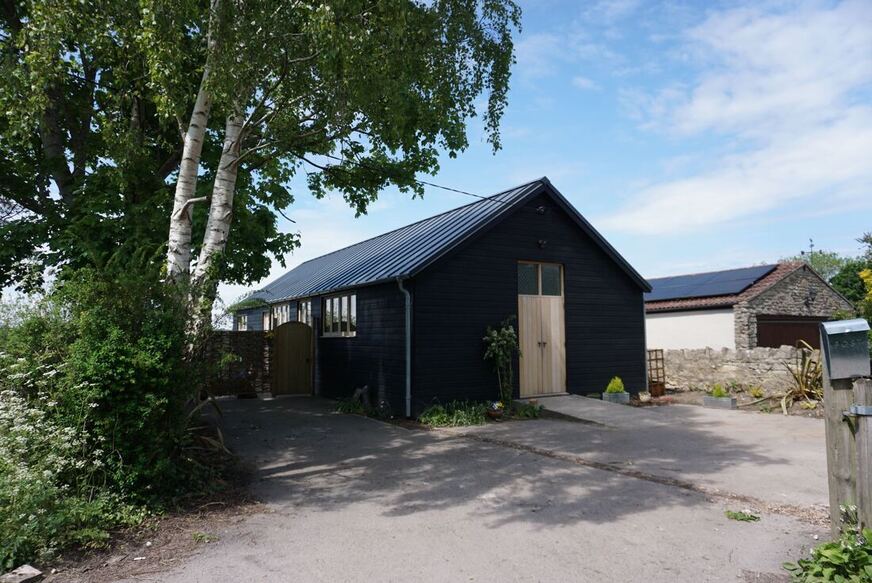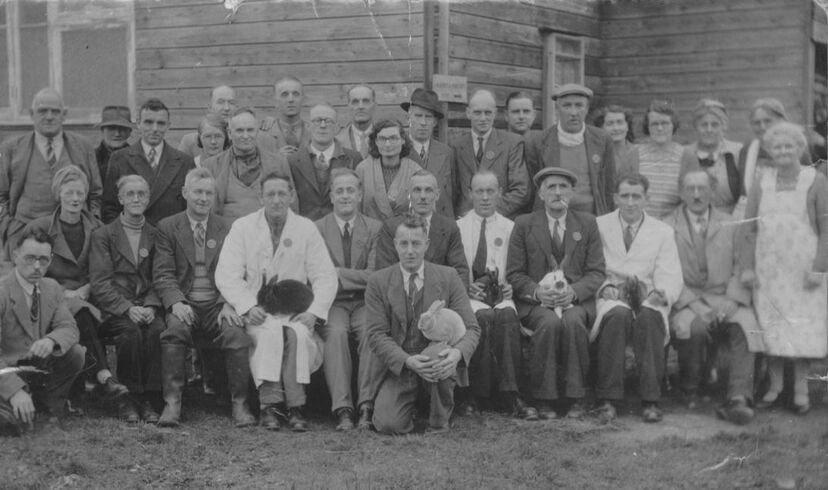The Box Hill Institute Alan Payne, August 2021
The Box Hill Institute didn’t start as a building at all. It began as a peripatetic social club for Box Hill residents, supported but not part of the United Free Methodist Church. It was first recorded in 1923 as a young men's club when Sister Lillian and Charles Oatley put on a social event of songs and recitations with refreshments at the Methodist Schoolroom, attended by 150 members and friends.[1] The evening was different to much that happened in Box with Mr A Dancey conducting selections with his jazz band. Early references make clear that it was aimed primarily at young men, with indoor activities and football matches, as in February 1924 when club members played Corsham Liberal Club at billiards. The club's ability with billiards was a disaster with newspapers usually reporting whitewashes to the opposition but the football club proved to be much more successful, running for many years. Activities were widened in the inter-war period with more emphasis on entertainment shows and humorous sketches for local men and women to enjoy.[2] In 1936 Herbert Ernest Tinson organised 70 members of Box Hill Institute to go on a motor-coach trip to Weymouth and Bill Greenland of Tunnel End, Box Hill, officiated at Institute meetings in 1937.
Members realised that the social club needed a base and they started to fundraise for a dedicated home. One event was a fundraising evening in 1937 with music from Percy Head and his Swingers, The Sailor’s Dance by Edwina Brunt and children in costume performing songs and routines.[3] In 1937 the Institute organised a Coronation Fete at the football pitch on Box Hill in honour of George VI.[4] Fundraising at the fete included a contest for locals to conduct the Corsham Town Band (no comment on the success of this) but the music was then redeemed by a professional conductor and dancing on the green until late.
Building the Hall
The actual building, the Institute Hall, has had a variety of names in the past – including New Hall, Black Hut, and The Shed.
It was built in 1938 on land donated by Frederick George Neate of Hillcrest.[5] The construction of the building was very controversial with local residents claiming that it had been erected on common land, whilst Fred Neate considered that the land belonged to him as part of Box Hill Common.[6] Members of the Institute paid the cost of the building and the first committee comprised secretary Herbert Tinson and treasurer Ellen Head.
The building was intended to be a meeting place for Box Hill residents and had a general-purpose hall 40 foot by 20 foot and a smaller room behind supplying accommodation for serving teas. The purpose of the building was to fulfill a long-felt want of a place for social recreation and a home for the Box Hill Institute. It was to be non-political, non-religious and open to all, and Captain Roger Alexander Legard was asked to formally open it as he had done so much at the Comrades Club in the centre of Box village. One of the first events was a wedding breakfast.
Members realised that the social club needed a base and they started to fundraise for a dedicated home. One event was a fundraising evening in 1937 with music from Percy Head and his Swingers, The Sailor’s Dance by Edwina Brunt and children in costume performing songs and routines.[3] In 1937 the Institute organised a Coronation Fete at the football pitch on Box Hill in honour of George VI.[4] Fundraising at the fete included a contest for locals to conduct the Corsham Town Band (no comment on the success of this) but the music was then redeemed by a professional conductor and dancing on the green until late.
Building the Hall
The actual building, the Institute Hall, has had a variety of names in the past – including New Hall, Black Hut, and The Shed.
It was built in 1938 on land donated by Frederick George Neate of Hillcrest.[5] The construction of the building was very controversial with local residents claiming that it had been erected on common land, whilst Fred Neate considered that the land belonged to him as part of Box Hill Common.[6] Members of the Institute paid the cost of the building and the first committee comprised secretary Herbert Tinson and treasurer Ellen Head.
The building was intended to be a meeting place for Box Hill residents and had a general-purpose hall 40 foot by 20 foot and a smaller room behind supplying accommodation for serving teas. The purpose of the building was to fulfill a long-felt want of a place for social recreation and a home for the Box Hill Institute. It was to be non-political, non-religious and open to all, and Captain Roger Alexander Legard was asked to formally open it as he had done so much at the Comrades Club in the centre of Box village. One of the first events was a wedding breakfast.
Box Hill Rabbit Club
Life in the 1940s and 50s was a time before television for most people, and clubs provided entertainment and opportunities for people who didn't want to socialise in the pub. The Rabbit Club at The Institute Hall appears to have been formed during the Second World War. It was a diversion from wartime austerity and an easy and cheap recreation for elderly men and women. It came to prominence in the Peace Celebrations of August 1945 when Messrs Williams, Couzens and Bezzant agreed to put on a Rabbit and Poultry Show in Fete Field (now Bargates) and raised £40.17s for the Peace Commemoration Fund.[7]
Their annual show became a huge event with 398 entrants in November 1945, six cups, four medals and classes called Breeders’ Challenge Cup, Beveren, Lilac Rex, Fur and Children’s Classes.[8] People came from miles around, those travelling by bus alighted on the A4 and walked up to the Common. Mr SW Hayter from Radstock took home a first prize in the Flemish Adult Rabbit Class in 1949.[9]
The idea of a club for rabbit-breeding seems rather quaint these days. At times it was somewhat macabre as in 1949 when the wife of visiting celebrity Wilfred Pickles was gifted a pair of fur-backed gloves made locally.[10] Charles WB Oatley was deeply attached to both the Pig Club and the Rabbit Club. He died shortly after visiting both clubs in 1950.[11] It was still in existence in 1955 when Frederick E Couzens of 2 Rose Cottage was the secretary but membership seems to have declined by the 1960s.
The hall has had numerous uses since then, including as a dance hall.[12] Harold May from The Wharf bought it at one time and, after him, it was converted into a carpenter’s shop. Bill Callaghan from Spafax used it for fitting out vans to distribute car accessories from the company base at Box Mill and Cheney Court.[13] In recent years it has been used as an audio recording studio. And now since 2020 it has a new name, The Lodge, and has been converted into a private house whilst still retaining the essence of the original building and continuing as a landmark on this part of Box Hill.
Life in the 1940s and 50s was a time before television for most people, and clubs provided entertainment and opportunities for people who didn't want to socialise in the pub. The Rabbit Club at The Institute Hall appears to have been formed during the Second World War. It was a diversion from wartime austerity and an easy and cheap recreation for elderly men and women. It came to prominence in the Peace Celebrations of August 1945 when Messrs Williams, Couzens and Bezzant agreed to put on a Rabbit and Poultry Show in Fete Field (now Bargates) and raised £40.17s for the Peace Commemoration Fund.[7]
Their annual show became a huge event with 398 entrants in November 1945, six cups, four medals and classes called Breeders’ Challenge Cup, Beveren, Lilac Rex, Fur and Children’s Classes.[8] People came from miles around, those travelling by bus alighted on the A4 and walked up to the Common. Mr SW Hayter from Radstock took home a first prize in the Flemish Adult Rabbit Class in 1949.[9]
The idea of a club for rabbit-breeding seems rather quaint these days. At times it was somewhat macabre as in 1949 when the wife of visiting celebrity Wilfred Pickles was gifted a pair of fur-backed gloves made locally.[10] Charles WB Oatley was deeply attached to both the Pig Club and the Rabbit Club. He died shortly after visiting both clubs in 1950.[11] It was still in existence in 1955 when Frederick E Couzens of 2 Rose Cottage was the secretary but membership seems to have declined by the 1960s.
The hall has had numerous uses since then, including as a dance hall.[12] Harold May from The Wharf bought it at one time and, after him, it was converted into a carpenter’s shop. Bill Callaghan from Spafax used it for fitting out vans to distribute car accessories from the company base at Box Mill and Cheney Court.[13] In recent years it has been used as an audio recording studio. And now since 2020 it has a new name, The Lodge, and has been converted into a private house whilst still retaining the essence of the original building and continuing as a landmark on this part of Box Hill.
References
[1] The Wiltshire Times, 13 October 1923
[2] The Wiltshire Times, 16 February 1924
[3] The Wiltshire Times, 13 March 1937
[4] Bath Weekly Chronicle and Herald, 3 July 1937
[5] Wiltshire Times and Trowbridge Advertiser, 30 April 1938
[6] Wiltshire Times and Trowbridge Advertiser, 12 December 1936
[7] Wiltshire Times and Trowbridge Advertiser, 25 August 1945
[8] Wiltshire Times and Trowbridge Advertiser, 17 November 1945
[9] Somerset Guardian and Radstock Observer, 20 August 1948
[10] Wiltshire Times and Trowbridge Advertiser, 1 October 1949
[11] Wiltshire Times and Trowbridge Advertiser, 9 December 1950
[12] Courtesy Mike Jacobs
[13] Courtesy Bob Hancock
[1] The Wiltshire Times, 13 October 1923
[2] The Wiltshire Times, 16 February 1924
[3] The Wiltshire Times, 13 March 1937
[4] Bath Weekly Chronicle and Herald, 3 July 1937
[5] Wiltshire Times and Trowbridge Advertiser, 30 April 1938
[6] Wiltshire Times and Trowbridge Advertiser, 12 December 1936
[7] Wiltshire Times and Trowbridge Advertiser, 25 August 1945
[8] Wiltshire Times and Trowbridge Advertiser, 17 November 1945
[9] Somerset Guardian and Radstock Observer, 20 August 1948
[10] Wiltshire Times and Trowbridge Advertiser, 1 October 1949
[11] Wiltshire Times and Trowbridge Advertiser, 9 December 1950
[12] Courtesy Mike Jacobs
[13] Courtesy Bob Hancock

